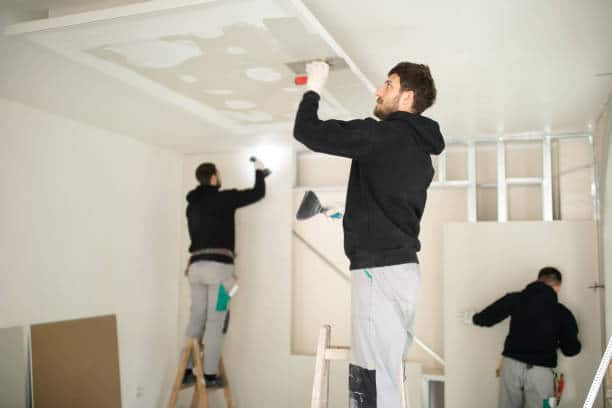Are you looking to spruce up your home with a ceiling refresh? One of the key questions you might have is how long does plaster take to dry on the ceiling? In this comprehensive guide, we’ll explore this crucial topic in depth. We’ll cover drying times, factors affecting drying time, methods for checking dryness, and even troubleshooting common problems. By the end, you’ll be well-equipped to handle your ceiling plastering project with confidence.
Table Of Contents
−- How Long Does Plaster Take To Dry on Ceiling: An In-Depth Look
- Factors Affecting Plaster Drying Time on Ceilings
- Humidity Levels in the Room
- Temperature Affects Drying Times
- The Thickness of the Plaster Layer
- Importance of Air Circulation
- Types of Plasters and Their Drying Characteristics
- How to Test If Your Plaster Is Dry
- Pro Tips for Accelerating Plaster Drying Times
- Troubleshooting Plaster Drying Issues
- Conclusion
How Long Does Plaster Take To Dry on Ceiling: An In-Depth Look
Drying time for plaster on a ceiling is not a one-size-fits-all answer. It varies significantly depending on various factors such as the type of plaster used, room conditions, and even the thickness of the plaster layer applied. For general plaster types, the drying time can range from two days up to ten days. Waterproof plaster, which contains special polymers to prevent moisture absorption, might take a different amount of time.

It’s essential to know that even when the plaster feels dry to the touch, you should allow it to cure further before undertaking activities like painting, drilling, or installing kitchen cabinets. A safe bet is to wait at least an additional 24 hours for the plaster to fully cure.
Factors Affecting Plaster Drying Time on Ceilings
When you’re trying to determine how long your ceiling plaster will take to dry, a variety of factors come into play. Understanding these variables can give you a better sense of timing for your project.
Humidity Levels in the Room
The humidity level in your room can either speed up or slow down your plaster’s drying time. High humidity can significantly extend the drying time. On the other hand, a drier environment will expedite the process. It is advisable to maintain a room humidity level of around 50% for optimal drying conditions. If you find the room too damp, using a dehumidifier can be a quick fix to regulate moisture levels.
Temperature Affects Drying Times
A cold room can be a significant impediment to the plaster drying process. Ideally, maintain room temperatures above 41 degrees Fahrenheit to ensure that your plaster dries efficiently. If needed, you can heat the room temporarily to meet this temperature requirement, but be careful not to overheat, as it may damage the plaster.
The Thickness of the Plaster Layer
The amount of plaster you apply has a direct correlation with the drying time. A thin coat might dry within an hour, whereas a thicker layer could take days or even weeks. For example, if you’re using multiple thin coats, expect around 12 working hours for it to be ready for painting. Conversely, a single thick layer might require up to two weeks of drying time.
Importance of Air Circulation
Proper air circulation in the room is indispensable for efficient plaster drying. Lack of air movement can slow down the process, leading to a longer drying time. To facilitate better air circulation, you can open windows and doors or use fans to circulate air effectively.
Types of Plasters and Their Drying Characteristics
Choosing the right type of plaster for your ceiling is crucial for both performance and aesthetics. The commonly used gypsum plaster is known for its quick drying time and ease of application. Lime plaster, although more expensive, provides superior moisture protection and breathability. Specialized plasters like acrylic or waterproof types are excellent for moisture-prone areas and can take 2-3 days to dry fully.
How to Test If Your Plaster Is Dry
Knowing when your plaster is dry is essential for progressing to the next phase of your project. You can rely on several methods to ascertain this:
- The Touch Test: Gently touch the plaster with your fingertip. If it feels damp or cool, it’s not dry yet.
- The Knuckle Test: Tap the plaster with your knuckle. A hollow sound indicates it’s still wet.
- Moisture Meter: This device measures room humidity, helping you determine if the plaster is ready for the next steps.
Pro Tips for Accelerating Plaster Drying Times
If you’re racing against time, a few tactics can expedite the plaster drying process. Enhancing room ventilation and increasing room temperature slightly can reduce the time needed for drying. Thinner plaster layers also dry faster, so consider this when applying.
Troubleshooting Plaster Drying Issues
Sometimes plaster might crack or flake when drying, especially if the room lacks proper ventilation or the plaster layer is too thick. To remedy these issues, ensure sufficient drying time before proceeding to paint or decorate. Spritzing the plaster lightly with water during the drying process can also prevent cracking.
Conclusion
The question of how long it takes for plaster to dry on a ceiling involves a nuanced understanding of various factors. Whether it’s the type of plaster used, the room’s conditions, or even how thickly you’ve applied the material, each plays a significant role. By being informed and taking appropriate measures, you can ensure that your newly plastered ceiling not only dries effectively but also stands the test of time.

Editorial Staff
Our writers, editors, content managers, and SEO specialist. We all take part in crafting amazing articles. We spend hours ensuring that each article is based on facts, researched, and thorough. You'll never want to click the back button to look for more answers other than here!
